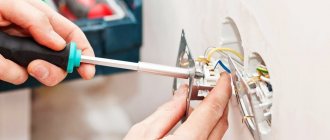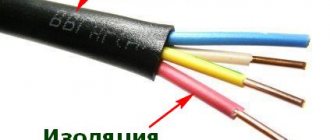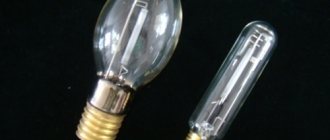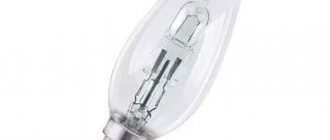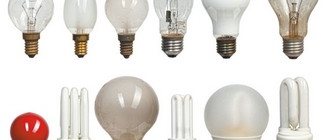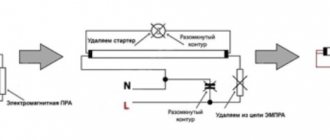Fluorescent lamps are highly efficient due to active mercury vapor placed inside the bulb. Under the action of a discharge, it emits a glow in the ultraviolet spectrum. Such lamps are completely safe for humans throughout the entire period of operation. But there is a danger when they explode. Because if the glass body of the lamp is damaged, there is a significant risk of mercury contamination of the environment and poisoning of people in this room. What should you do if a fluorescent lamp breaks? It is obvious that it is necessary to take urgent measures to dispose of it and neutralize toxic substances.
How to use a fluorescent light bulb
If fluorescent light bulbs are used correctly, they will not cause harm. The following few rules will help prevent a fluorescent lamp from breaking:
Safety precautions when working with electrical equipment: general information and basic measures
A fluorescent lamp has been broken: take precautions and dispose of it correctly!
RCD in power supply circuits of drive frequency converters
- Periodically check the light bulbs for their integrity, especially for those light bulbs that have regularly worked for more than one year.
- It is necessary to check the integrity of the light bulbs before screwing them into the lamps. Even if a new light bulb has minor cracks on the bulb, it is better to return it under warranty with a mandatory indication of the reason for the return.
- Careful handling of the light bulb is the key to the integrity of the mercury flask. You only need to screw it in and out by holding it by the body, and under no circumstances apply force to the glass component, because of this the flask may crack right in your hands.
- You cannot use very tight lampshades and shades - energy-saving light bulbs over 10 watts tend to get very hot, which is why in low-quality and defective products the electrical circuit may catch fire, which will lead to physical damage to the bulb and it may even explode.
- Initially, you need to buy products from a trusted company that guarantees the quality of its products. A good manufacturer monitors the production of light bulbs at all stages of the process, so they arrive at the point of sale fully operational and with the appropriate codes and certificates.
High-quality fluorescent lamps must comply with quality certificates
Obvious disadvantages
Despite the fact that fluorescent lamps have a good set of advantages, using such daylight sources at home also has a lot of disadvantages. However, many of them can lead to deterioration in human health. It is worth mentioning here that the cost of such light bulbs is quite high. This minus ranks next after the harm that such products can cause to the human body. The negative aspects of using fluorescent lamps include:
Dermatitis
- presence of ultraviolet radiation. People with various skin diseases should be very careful with such light bulbs. Otherwise, dermatitis, eczema, pigmentation, psoriasis, etc. may appear. In critical cases, skin cancer may even develop. But to get such negative consequences, the light source must be used for a very long time;
- side aspects of the work - flickering or stroboscopic effect. This is another significant disadvantage in the operation of fluorescent lamps, which directly affects the visual system. The blinking speed of such a light bulb can reach 50 times per second. Such flickering is very painful for the eyes. They begin to water, visual acuity decreases and general eye fatigue increases. Flicker can also lead to distortion of the visual perception of objects;
Note! Flickering can be corrected by installing 2 or more products in the lamp. This will reduce visual discomfort and reduce damage to the eyes.
- lack of inertia. As a result, such lamps light up with a slight delay. It can also cause visual discomfort. In this situation, the eye muscles try to adjust the lens to the changing light/dark criterion and cannot always cope with this effectively.
Note! Even following all the rules for using the product will not help level out all of the above negative aspects. This will only minimize the harm, but it will still not be possible to completely eliminate it. The operation of such light bulbs is especially dangerous for young children whose visual system is at a developing stage. After a year of exposure to such a light source, children are diagnosed with decreased visual acuity and may even need glasses.
What not to do if a fluorescent lamp breaks
Do not disassemble or repair yourself
Many people, when a light bulb burns out, do not want to buy a new one, but try to fix it with their own hands. Trying to save money. Because in expensive light bulbs the failure is often so small that it can be eliminated by soldering several capacitors. However, it is important to remember that incompetent intervention in the light bulb can lead to depressurization of the bulb, which contains mercury! This is especially dangerous if the toxic substance gets on the skin of your hands. Because there is a high probability of mercury entering the lungs. Therefore, it is advisable to refrain from disassembling the light bulb. You should properly dispose of it and buy a new one, while following all the recommendations in this article.
A list of what else should not be done if a fluorescent lamp breaks:
- In no case should you collect fragments with a vacuum cleaner - it will spread mercury even more throughout the room, and the filters will be saturated with its vapors for a long time;
- also do not turn on the air conditioner and fan;
- do not use a broom - dry material is well saturated with mercury, and glass fragments can get stuck in the broom itself;
- Do not throw the trash bag down the drain.
Adviсe
If you want to use such products, you should consider the following recommendations:
- You need to choose collagen models, they are less harmful.
- For residential premises, lamps with a power exceeding 60 watts should not be installed. If the lighting is insufficient, it is advisable to use several light sources.
- It is advisable to choose light bulbs that have an operating temperature of no more than 3100 Kelvin and a yellow glow.
- During installation, careful handling of the lamp is required to avoid damaging it. If it breaks, then you need to open the windows and leave the room to ventilate the mercury gases. After this, you need to remove the fragments and dispose of them. Then you need to treat the room with a chlorine solution.
- If a tabletop lighting device is used, the lamp must be installed at a distance of at least 15 cm from its permanent place of residence.
Experts do not advise throwing products in the trash, since fluorescent lamps are known to be harmful to the environment. Their components penetrate the soil, infecting it. The smell of fluorescent lamp wiring is known to be harmful.
What to do if a fluorescent lamp breaks
If a fluorescent lamp breaks, there is no need to panic. The action plan is as follows: remove children from the premises if they are in it, neutralize and collect mercury, collect all glass fragments.
Why you can’t leave a charger in a socket (charger): what the consequences are, reviews
Demercurization of the premises
Demercurization is a process to neutralize mercury that has entered the room openly. This process consists of several stages:
- If you think that when a light bulb is broken, the mercury will be in the form of balls (like in old thermometers), then you are deeply mistaken. And therefore, it is necessary to immediately ventilate the room for at least 2 hours. Use personal protective equipment, gloves, goggles and a chemical respirator. If you don’t have this on hand, because not every home has such a set, be sure to wear rubber or other waterproof household gloves. Using a sheet of thick paper (if you don’t have it, cardboard will do) make a scoop into which you can collect the fragments and mercury powder of a broken light bulb; a rag is convenient for doing this if the fragments have fallen under the cabinet. It is advisable to carry out collection with a damp, thick cloth. All fragments with mercury residues are moved with a rag onto a homemade scoop.
- The rag, dustpan and collected debris should be placed in a thick plastic bag and tied very tightly. For greater reliability, one bag can be placed in several more bags so that the fragments do not cut the polyethylene (also, before moving the fragments into the bag, you can pour them back onto a rag and wrap it carefully).
- Do not allow splinters to remain on the floor for long periods of time. It is advisable to treat the place where the lamp fell and broke with a solution of potassium permanganate or any bleach based on active chlorine. If this happens on the carpet, then it needs to be taken outside, carefully but thoroughly shaken out, and left to air out as much as possible.
- The bag should not be thrown into a container or trash can with other waste. It must be handed over to the nearest organization that disposes of mercury, for example, a fire department, housing office or private office. They will accept your package free of charge or for a nominal fee, after which the mercury will be neutralized with special chemicals, and the glass will be sent for recycling.
Broken fluorescent lamp: take precautions
Why you shouldn't throw a broken lamp in the trash
The above steps will not allow a broken light bulb to pollute the environment with mercury vapor, no matter how much it is contained inside. After neutralizing the mercury, the fragments can serve as material for the production of a new product, which will significantly reduce production costs and preserve the environment. This occurs subject to the removal of the broken lamp to special institutions that work under an agreement with the manufacturers. Modern production of compact fluorescent lamps is gradually being reduced due to the difficulty of recycling mercury, so the material will be used to manufacture a new trend in lighting technology - LED lamps.
RCD in power supply circuits of drive frequency converters
Disposal
1 light bulb contains 7 mg of mercury. Although the indicator is small, you cannot throw it in the trash. Since the harm of fluorescent lamps is obvious, the manufacturer advises recycling failed energy-saving devices. This work is carried out by district departments:
- Directorate for Building Operations (DEZ).
- Repair and maintenance departments.
But as you can see from practice, such light bulbs end up in landfills. Manufacturers advise finding a company that disposes of mercury waste and entering into an agreement with it. But these services are paid, and there is no compensation from the state. Such energy-saving products are becoming more and more popular, so an environmental disaster is expected in the future.
How else can you quickly remove the remains of a broken fluorescent lamp?
To efficiently remove small fragments, you can use stationery tape, gluing sticky strips to the place where the light bulb was broken. The glue collects glass well, which is invisible to the human eye due to its small size, and also glues remaining mercury, which increases the quality of assembly. There is no need to call a special service for demercurization. Because a small mercury content will not lead to a global environmental disaster.
The mercury content in fluorescent lamps depends on their power and is 0.1-0.5 grams. If mercury from a broken thermometer in the form of balls is relatively easy to collect, then with its vapors everything is much more complicated. And, although the contents of the flask are not fatal to humans, nevertheless, there is a very real danger of poisoning. When a fluorescent lamp breaks, the very first action to neutralize harmful substances is to ventilate the room. Due to this, the concentration of mercury vapor is noticeably reduced, the main thing is that this procedure is carried out in a timely manner.
After complete removal of particles, it is necessary to treat all surfaces with a special solution, which can reduce the concentration of vapors. It is permissible to prepare the solution yourself. Preparation in three ways is possible: 2 grams of manganese are dissolved in a liter of water; for 10 liters add 400 grams of soda and part of liquid soap; Dissolve 100 ml of iodine in a liter of water. This procedure takes 3–4 days. The resulting composition is applied to the affected area and left for 6-8 hours. Particular attention should be paid to the cracks between the floorboards, where mercury could roll in and the phosphor could spill out. There is no need to spare the solution - our health depends on the quality of demercurization.
It is necessary to treat the surface with a solution that can be prepared from available ingredients
What is an overcurrent circuit breaker and how to choose one
What not to do?
- Turn on the air conditioner if there is one - mercury vapor will settle inside the device.
- Collect the remains of the lamp with a vacuum cleaner - again, the mercury will settle inside.
- You should not use a broom - careless movements can scatter small pieces of glass around the room.
- Pour the jar of water and remaining glass down the drain.
- Throw away the broken lamp or the can with the remains of the lamp in the trash or down the garbage chute.
Used (burnt-out) energy-saving lamps cannot be disposed of together with household waste; they should be taken to special collection points.
Dangerous consequences of broken fluorescent lamps
Many people are very aware of the harm that mercury can cause to the body. The mercury vapor contained in the flask is much more dangerous than mercury in its pure form. Their main harm lies in the fact that from a destroyed lamp they enter directly into the respiratory tract, and then penetrate into the body through the lungs.
Mercury belongs to the first class of hazardous substances according to the FKKO, so it causes a negative reaction in the body even in very small amounts of grams when a person inhales it. It has a cumulative property, that is, in a short time, biological tissues accumulate mercury, and it is very difficult to remove it. Symptoms look like typical toxic poisoning:
- sharp abdominal pain;
- nausea and diarrhea with blood;
- heat;
- inflammation of the lungs and gums.
Mercury is especially dangerous for pregnant women. Mild poisoning is manifested by apathy, memory loss, drowsiness, and bad mood. If such symptoms are observed after disposal of fragments, urgent hospitalization of the victim is necessary, where doctors will prescribe special substances that neutralize the harm of mercury in the body.
Color and alphanumeric markings of electrical circuits
Symptoms of mercury vapor poisoning
Consequences
Mercury vapor is dangerous to health because it can cause chronic poisoning, which is manifested by hand tremors, gingivitis, and disturbances in the functioning of the central nervous system. With a high concentration of vapors (massive breakdown of energy-saving light bulbs), acute mercury poisoning is possible, which is manifested by weakness, abdominal pain, vomiting and bleeding gums (see symptoms of mercury poisoning).
Mercury in vapor form is most dangerous for children and pregnant women, so it is important to know how to act in such a situation. One broken lamp will not cause serious harm, but this does not mean that precautions can be ignored.
What to do if you have severe mercury poisoning
The most dangerous variant of mercury vapor poisoning is acute poisoning, and in this case a large amount of mercury vapor enters the human body over a short period. In this case, the consequences will not take long to arrive. A couple of hours and the primary signs of poisoning will appear. And they are diverse. From abdominal pain to bloody diarrhea, from pneumonia to swollen gums, nausea and vomiting. Most often the temperature rises to at least thirty-eight degrees. In case of particularly severe poisoning, death is possible. But let's not talk about sad things. This is actually not a common occurrence. Most likely, a broken light bulb will not poison you, but no one has canceled safety precautions.
How to fix bluetooth headphones for a phone, if one doesn’t work, the microphone or plug is broken, the contact has come loose and other cases
It is more dangerous to break a hot energy-saving fluorescent lamp. The most harmful fumes are hot ones. According to statistics, mercury poisoning occurs extremely rarely in domestic conditions, but, however, you need to be careful not to become one of the sad statistics.
The effect of mercury lamps on human health
Two more types of mercury poisoning not associated with a broken lamp
The next two types of poisoning have nothing to do with a broken lamp at all, but it is useful to know about it. At a minimum, to know how to act in such a situation. The first of these is chronic mercury vapor poisoning. It occurs as a result of prolonged exposure to vapors with a slight excess of mercury content. This impact can last up to several years. And it affects the central nervous system. Depending on the type of lesion, symptoms appear. It could simply be fatigue, drowsiness or apathy. In more severe forms, the effect on the brain is manifested, and this is bad. There may be memory loss and severe tremors in the limbs.
Meter box: requirements for a metal case for outdoor installation of a meter
The second form is micromercurialism. This poisoning occurs gradually. As a rule, over a very long period of time, the body is constantly exposed to a tiny concentration of mercury vapor. Long before the appearance of primary symptoms, the ability to smell is sharply reduced. Signs of such poisoning include decreased performance, drowsiness, apathy and memory loss. This general poisoning of the body also leads to a reduction in immunity. Most often, such poisoning occurs in those who work in mercury-related industries and neglect safety measures. But the reasons may be different, and such poisoning is possible in domestic conditions. Especially in cases where the mercury from the broken thermometer was not carefully removed. It can lie in the folds of the parquet, evaporate and slowly poison you.
Properties of mercury
All concerns about the use of fluorescent lighting did not arise out of nowhere. After all, the production of lamps uses a small amount of mercury vapor, which is poisonous to humans, according to most. Understanding the meaning of this stereotype will allow knowledge about the properties of this only naturally liquid metal.
From chemistry course we know that at room temperature mercury is in a liquid state. In itself, this heavy silver metal is not dangerous. However, mercury is capable of evaporating even at such a low temperature, not to mention its more serious values. These vapors are capable of not only independently distributing through the air indoors, but also forming volatile compounds with organic substances and being absorbed on household items, furniture, and even ordinary dust particles.
Drops of mercury in a test tube
Vapors can penetrate building materials, water and soil. Liquid mercury has a low viscosity and high surface tension, which helps to separate one drop into many smaller ones. This further increases the evaporation area. Liquid mercury particles are very mobile, which makes demercurization of the room very difficult. They dissolve easily in organic solvents and even in water in the absence of free oxygen. At pH = 8, solubility is at a minimum. When this indicator changes in any direction, the solubility increases. Liquid mercury can easily dissolve some metals, even noble ones. In this case, so-called amalgams are formed. In this regard, it is natural that this substance has a destructive effect on metal structural materials.
The chemical properties of mercury are such that it is very highly ionized, and this creates great difficulties in converting its vapors into relatively safe salts. At room temperature, its oxidation in air is impossible. Very strong oxidizing agents are needed. Even dilute acids, such as sulfuric and hydrochloric, are not suitable. Concentrated nitric acid or aqua regia is required for the mercury oxidation reaction to take place. It is the difficulty of neutralizing this toxic substance that necessitates the need to take serious safety measures when using mercury in various devices, including fluorescent lamps.
How much mercury is in an energy-saving light bulb?
The concentration of mercury inside an energy-saving light bulb depends on its type and power. Each manufacturer indicates the indicator on the individual lamp packaging:
- Room ESL contains up to 5 mg of mercury.
- DLR lamp – up to 350 mg.
- Luminescent tubular – 45–65 mg.
- DRT lantern – up to 600 mg.
- Neon tube – up to 10 mg.
Experiment with a broken fluorescent lamp
Attention! Back in 2004, applied research was carried out on breaking down fluorescent lamps. “Full-scale tests” were carried out inside a closed container in which an energy-saving lamp broke. The experiment gave the following results:
Replacing electricity meters: at whose expense is the electricity meter changed and in what case
Mercury vapor is dangerous to human health
- Immediately after breaking the flask, more than 50% of the total amount of mercury vapor it contained is released.
- Mercury in amounts up to 40% is gradually released from the fragments in the form of vapor. (The remaining amount remains on the bound inner lining of the broken flask).
- In the first 24 hours, approximately half (i.e., up to 20% of the total amount) of the toxic metal is released from the fragments. As a result, after 24 hours, at least 70% of 2.5 mg of mercury (the most common content) will accumulate in the atmosphere of the apartment, if ventilation is not done.
- In high-quality foreign lamps, mercury is usually contained in a special bound state, in the form of a so-called amalgam. And when the lamp breaks, mercury in contact with air should not spread in space. Chinese analogues, if damaged, pose a real danger. One light bulb can contain up to five milligrams of mercury. For comparison, for example, a thermometer contains only 2 mg of mercury. And since it is in a gaseous state in the lamp, its distribution in the air occurs very quickly. The minimum safe daily dose of mercury for one person is 0.0003 mg/m3.
How to correctly report data for electricity: how to transmit, when and in what way
Saving on health?
Fluorescent light bulbs in modern apartments, houses and offices are actively used to create basic or additional lighting. This is due to the fact that fluorescent lamps have the following advantages:
- High light parameters.
- Energy saving.
- The useful service life of a fluorescent lamp is 10-12 times longer than usual.
The presence of such advantages in the operation of fluorescent lamps allows them to be among the most common light sources. The real benefits of using them will be noticeable almost immediately.
Types of mercury lamps
The main types of lamps containing mercury are presented in the following list:
- Fluorescent tube lamp. This is a well-known fluorescent lamp (LDS). It can be seen almost everywhere: in everyday life, public places, offices, industrial premises;
Tubular (LDS - fluorescent lamp)
- UV lamp. It is also called quartz, although this is not entirely true. The filling of such a lamp is the same as that of an LDS, only it does not have a phosphor and is made of special glass. These lamps are also found everywhere: in household disinfection devices, solariums, beauty salons, medical institutions, etc.;
Quartz (ultraviolet) fluorescent lamp
- Compact fluorescent lamp (CFL). In essence, this is the same LDS, only compact and having built-in control gear. There are these in almost every home - they have replaced incandescent lamps;
CFL
- Mercury arc lamp (MAL). This device recently served as the main source of lighting for streets, roads, and industrial enterprises. Nowadays it is found somewhat less frequently, but is still very popular;
DRL
- Sodium arc lamp (HSA). This is also an industrial lamp. She slightly pushed aside the DRL devices, but only a little - her light was too orange. The device can be seen in cantilever street and road lamps;
DNAT
- Metal halide lamp (MHL). The scope of application is the same as that of DRL devices. In addition, it can be found in relatively “household” devices - movie cameras, projectors, episcopes, etc.
MGL
How to properly design corners on a ceiling plinth
What to replace it with?
It is preferable to choose only from 2 types of devices. The first include incandescent lamps. They are considered the safest, but they generate expensive light. You can use LED lamps, which can save humanity from the adverse consequences of using energy-saving lighting devices.
LEDs contain no mercury. They do not heat up well during operation. Light output is higher compared to fluorescent lamps. Low consumption and safety are strong arguments in favor of light-emitting diodes, from which all such lamps are created.
The high cost is not a disadvantage, since LED lamps work 5 times more compared to energy-saving analogues and 30-50 times more compared to incandescent lamps. Since there is an excellent replacement for dangerous mercury-containing devices, it is better to use safer light sources.
Procedure
- Immediately turn off the climate control devices (air conditioner, fan, etc.).
- Remove all family members and domestic animals, if any, from the premises.
- Organize high-quality ventilation of the room. In this case, it is necessary to exclude drafts, for which all doors to adjacent rooms are tightly closed, and the windows are fully opened. It is impossible to clearly indicate the exact time of such natural ventilation, since everything depends on local conditions - the dimensions of window openings, the “square” of the room, the wind rose and a number of others. You should focus on the minimum period, which experts determine to be 2 hours. Although to fully guarantee high-quality ventilation, at least 12 may be needed.
- Recycle broken energy-saving light bulbs. All work is carried out only in protective equipment, primarily for the hands. If you don’t have rubber gloves at home, you can replace them with regular plastic bags. It is recommended to collect the fragments with a damp cloth; their storage is organized in any suitable container with an airtight lid. As a rule, this is a glass jar that is pre-filled with water.
- Thoroughly wash the floor in the area where the lamp broke. Any chlorine-containing product or soap-soda solution will do.
Recommendations for demercurization
This is the name of the measures, the purpose of which is to neutralize the effects of mercury vapor and its chemical compounds. In this case – wet cleaning.
Recipes for the preparation of drugs (in g/l).
- Iodine (100 ml). For small areas.
- Potassium permanganate (2). It processes the entire segment where fragments of an energy-saving lamp have scattered. Waiting for at least 6 hours, after which the floors are washed again with soapy water.
- Baking soda (40). Instead, you can use detergent (optionally, “Whiteness”).
If the lamp breaks on the carpet, then it needs to be taken outside, thoroughly knocked out and left there for a while for proper ventilation.
What is prohibited:
- Use a vacuum cleaner to collect light bulb fragments.
- Pour the contents of the container (can) into the sewer system.
- Reuse the rags used to collect the fragments. They are also recyclable.
After wet cleaning, it is advisable to immediately take a shower to wash off all the “dirt.”
But what to do with the assembled parts of an energy-saving light bulb needs to be clarified with the Ministry of Emergency Situations. The attendant will advise you on how to properly dispose of the remains of hazardous products. Each locality has its own way of organizing this process. In some, there are containers everywhere that are designed specifically for collecting such waste, in others there are special collection points.
How dangerous is this situation?
This situation cannot be called pleasant, but if a person breaks such a lamp, you should not panic or call specialists. True, this statement is relevant if this happened with one lamp. But if several of them crashed at once, this is already a serious reason to call for help. After all, inside such a device there is a mercury almagam , that is, mercury vapor. This substance is classified as hazard class 1. This substance is located inside the tube. Accordingly, it comes out when the tube breaks or its integrity is compromised.
Very often people confuse the mercury filling and the luminescent coating inside the glass tube. During operation, this coating may fall off inside the lamp. If this happens, there is no need to worry, because only after the integrity of the lamp is damaged, mercury evaporates from the lamp.

